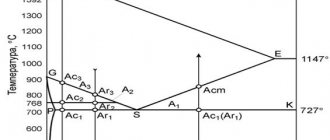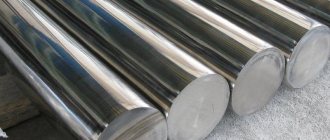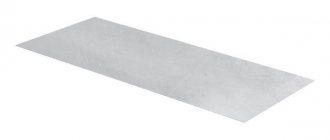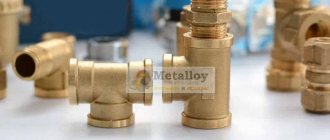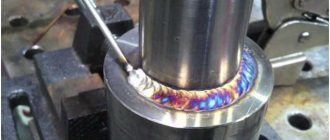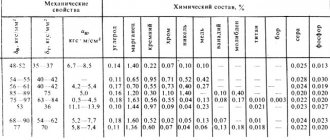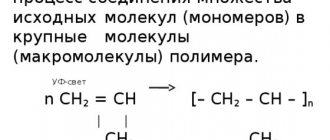Low carbon steel and its main characteristics
Low-carbon steel is an alloy that does not contain alloying elements, has impurities and a low carbon content, up to 0.25%. This alloy contains manganese and silicon, but due to its low percentage (manganese - no more than 1%, silicon - no more than 0.8%), they do not have a noticeable alloying effect on the material. Low-carbon steel is soft and has a low manganese content.
Due to its softness, this alloy does not allow precise surface processing, but its softness, toughness and ductility make it possible to create cemented workpieces and parts for subsequent welding/cementation. The machinability of the alloy is very poor, the surface of the workpiece has many roughnesses. Carrying out precise processing is quite difficult.
Welding Features
Welding low-carbon steels has high performance. The type of welding, electrodes and their thickness are selected based on the following technical data:
- The connection must be firmly fastened.
- There should be no seam defects.
- The chemical composition of the seam must be carried out in accordance with the standards specified in GOST.
- Welded joints must comply with operating conditions (resistance to vibration, mechanical stress, temperature conditions).
Various types of welding can be used, from gas welding to carbon dioxide welding with a consumable electrode. When selecting, take into account the high fusibility of low-carbon and low-alloy alloys.
As for the specific scope of application, low-carbon rolled products are used in construction and mechanical engineering.
So, we found out what products made from low-carbon and low-alloy steel are.
Source of the article: https://fb.ru/article/266192/nizkouglerodistaya-stal-sostav-i-svoystva
Properties of Low Carbon Steel
The properties of low carbon steel do not have high strength values. Plasticity and viscosity, on the contrary, are high. Low-carbon steel grades are sometimes intended for the manufacture of case-hardened products that require additional case-hardening to achieve the required hardness and make them wear-resistant through further processing. Products made from such steel are quite well welded and forged.
The properties of low-alloy steel do not allow full-fledged work with this metal. However, if the process of normalization and cold drawing is carried out, the machinability of the surface can be significantly increased. Due to good ductility (5 = 33...23%), low-carbon steels can be successfully subjected to cold deformation, without losing mechanical properties, since local overstress is evenly distributed and cracks do not form. Such steel is weakly hardenable and welds well.
The properties of low-carbon steel have a number of disadvantages:
- low strength Te = 330...460 MPa, Sto.2 = 200...280 MPa;
- low impact strength;
- very sensitive to mechanical aging, since under repeated loads it senses stress concentrations, so products subject to repeated loads are not made from it.
Grades of low-carbon steel, their main areas of application
The grade of low-carbon steel, depending on its composition, has specific purposes in industry. This type of alloy includes 05 kp, 08, 10, 10 ps, which are actively used for the production of washers, gaskets and other light-loaded structural elements and machines. Depending on the grade of low-carbon steel , the alloy is used in different industries. Thus, high resistance to static hydrogen fatigue is demonstrated by:
The following grades of low-carbon steel are used as case-hardening steel:
In the manufacture of gears with subsequent cementation, the following is used:
- EP620;
- EP355;
- 03 are used as a charge billet and are produced in the form of rods of various sizes. This charge additive is used in the process of smelting special alloys for the manufacture of individual parts and special rolled products.
To create welded structures, the following grades of low-carbon steel :
- St0;
- St1sp;
- St1ps;
- St1kp;
- St2sp;
- St2ps;
- St2kl;
- St3sp;
- ST3kl (GOST 380);
- steel 10;
- steel 15;
- steel 20 (GOST 1050);
- S235-S295;
- P235-P295 (EN 10025, EN 10027-1, EN 10028-2).
For alloys produced in the CIS countries, as well as in accordance with the established GOST rules, steel marking is carried out as follows:
- the letter in front of the brand name indicates the group to which the alloy belongs (there are only three groups A, B, C, group “A” is not indicated when marking);
- "St" or "steel" indicates that the alloy is common;
- the first digit in the stamp indicates the GOST number, a number from 0 to 6;
- the degree of deoxidation is indicated by the following abbreviations: “sp”, “ps”, “kp” (in the case of steels “A” of group, the designation “sp” is not indicated and is accepted as such by default);
- the next digit is the steel category number, according to GOST from 0 to 6. The first category is not indicated in the designation;
- if the marking indicates a dash between the first and second digits, this means that the steel was not subject to requirements for the degree of deoxidation.
Source
Manufactured products
There are several groups of steel products:
- Sheet steel. Subtypes: thick-sheet (GOST 19903-74), thin-sheet (GOST 19904-74), wide-sheet (GOST 8200-70), strip (GOST 103-76), corrugated (GOST 8568-78)
- Angle profiles. Equal flanges (GOST 8509-93), unequal flanges (GOST 8510-86).
- Channels (GOST 8240-93).
- I-beams. Ordinary I-beams (GOST 8239-89), wide-flange I-beams (GOST 26020-83, STO ASChM 20-93).
- Pipes.
- Profiled flooring.
Secondary profiles are added to this list, which are formed through welding and machining.
Variety of low carbon steels
Low-carbon alloys contain impurities of various types. Increased sulfur and phosphorus content directly affect the properties of the metal and can lead to cracking during processing. Manganese and silicon do not reduce characteristics; they participate in the process of deoxidation and oxygen removal. Oxygen is removed to increase the strength of the material during hot deformation.
According to the degree of oxygen removal and deoxidation, steel is classified into:
Low-alloy steels are an alloy with a low carbon content and small amounts of alloying additives, a total ratio of up to 4%. Alloying elements are needed to increase any performance properties while maintaining good welding characteristics. Increased resistance of the metal to corrosion and the ability to work at extremely low and high temperatures without deformation is achieved by alloying.
The quality of low-carbon steel is determined by the content of sulfur and phosphorus impurities in the alloy.
Based on the type of properties, they are distinguished:
- Usual quality. Sulfur in the composition - up to 0.06%, phosphorus - up to 0.07%.
- High quality steel. Mass fraction of sulfur - up to 0.04%, phosphorus - up to 0.035%.
- High quality steel. Sulfur content - up to 0.025%, phosphorus - up to 0.025%.
- Special quality. Minimum presence of impurities: permissible values of sulfur - up to 0.015%, phosphorus - up to 0.025%.
Composition according to GOST
Steel is an alloy of iron and carbon, the percentage of the latter should not exceed 2.14%. Anything above this value is already cast iron. Low-carbon steel is characterized by a reduced carbon content, which leaves its mark on both mechanical and technological properties.
There are several standards that regulate the composition of carbon alloys. Among them, the most popular are GOST 380-2005 and GOST 1050-90. According to them, low-carbon steel can be called steel that includes:
- Carbon (up to 0.25%). It allows you to thermally strengthen steel, as a result of which the hardness and temporary resistance of the metal can increase several times.
- Silicon (up to 0.35%) It improves mechanical characteristics, especially impact strength and strength. Also, an increase in silicon in the alloy has a positive effect on weldability.
- Manganese (up to 0.8%) belongs to the group of useful impurities. Its molecular structure is similar to oxygen and actively enters into a chemical bond with it, which prevents the formation of iron oxide. Steel alloyed with manganese is more homogeneous in composition, copes better with dynamic loads, and becomes more susceptible to thermal hardening.
- Sulfur (up to 0.06%) is a harmful impurity. Makes the metal red-brittle and complicates pressure processing: forging, rolling, etc. Reduces weld density. Increases temper brittleness.
- Phosphorus (up to 0.08%) is responsible for the appearance of cold brittleness. Distorts the crystalline structure of steel. Reduces its impact strength. Deteriorates the strength and endurance of the metal. But phosphorus is not always a harmful impurity. In some cases, its addition is justified, because it increases the metal's ductility to cutting. But still, its total amount should not exceed 0.1%.
- Oxygen is the most undesirable element in steel. The introduction of 0.001% oxygen can reduce the strength of the metal by 50%. Prevents processing of the alloy with a cutting tool.
- Nitrogen. After it gets into the metal, it forms iron nitrides - a very brittle compound that reduces both the strength and technological properties of the alloy.
Carbon structural steel
The quality of rolled metal of this type can be ordinary or high. Material of ordinary quality is cheaper due to less purification from harmful components, and is distinguished by a large number of non-metallic impurities.
Gradation by quality indicator
Structural steel of ordinary quality, according to GOST 380-94, is subject to classification into three characteristic groups:
- A – alloys of this group do not require further heat treatment, which helps to preserve the original properties of the original metal. The marking is standard - the letters “St” plus numbers indicating the degree of strength and ductility – St1, St3, etc.
- B – the guaranteed chemical composition of the material of this group is amenable to deoxidation. The marking contains the letter “B” indicating the degree of deoxidation at the end - BST3sp (calm), BSt1kp (boiling). The number represents the percentage of carbon.
- B – a group of high-quality steels with a guaranteed chemical composition that can withstand mechanical processing. Marked with the letters VSt1, VSt3, etc. To produce metal products from this group, additional processing will be required, mainly by welding.
Rolled metal of ordinary high-quality composition is used for the manufacture of parts requiring welding, necessary for working under light load conditions. Structural steel of this type is mainly used in the automotive industry, as well as in the construction industry for mass-produced structures.
Ordinary metal of the appropriate grades is used for the production of nails, wire, and rivets. The structural material is used to produce axles and shafts that operate under light loads, various types of fasteners, and are used to produce shaped rolled products.
A high-quality type of carbon alloys must comply with GOST 1050-88; the production of alloys requires strict compliance with the parameters of composition, melting, and casting. Requirements for the characteristics of the chemical composition provide for the mandatory content of harmful additives - 0.04% each of sulfur and phosphorus. The marking of improved structural materials is located in the number range 08-85 (Steel08, Steel15, Steel80, etc.).
Restrictions
The carbon content, indicated by a digital index, imposes certain restrictions on the quality and scope of steel products.
| Name | Product properties, scope of application |
| Low carbon | Lightly loaded parts made of this material are characterized by low strength with high ductility and weldability. The products are suitable for cold stamping, excluding heat treatment. The metal alloy is used to produce complex parts for automobiles and critical welded structures. |
| Medium carbon | Medium-carbon structural steel becomes after improvement by hardening and hot tempering (up to 650°C). These indicators increase the strength of steel parts, but reduce ductility, which allows cutting. High-strength material improved by hardening is used in mechanical engineering |
| High carbon | High carbon materials are characterized by a high percentage of manganese. This type of metal is used to produce products that require increased elasticity and wear resistance (springs, springs). After annealing, the material lends itself well to cutting |
| Quality | Construction material of this category contains an increased proportion of impurities - sulfur-phosphorus, lead additives. High-quality metal is used to produce parts that undergo advanced processing that does not harm metal-cutting tools. This is a class of automatic steels enriched with sulfur, phosphorus, and lead, intended for use on automatic machines |
To increase the wear resistance of metal products, graphitization, cold hardening, and surfacing are used. Such methods of improving the parameters of structural steel make it possible to increase the hardness of the material and its resistance to wear.
Application area
The specific area of application of carbon metal products is determined by its characteristics.
| Structural alloys | Properties of steels, areas of application |
| Mechanical Engineering | Used for automobile production due to its high mechanical properties that extend to the entire material. Machine parts are reliable, resist heavy loads and impacts well, maintaining increased strength |
| Building | Carbon alloys are used to make bridge structures, trusses, and equipment for oil and gas pipelines. The main requirement for structural steels of this type is good weldability with a small volume of alloying components. Alloying with silicon and manganese contributes to increasing strength. |
| Reinforcing | Reinforced concrete structures are reinforced with steel reinforcement, which helps to increase their strength when exposed to loads. This type of metal is represented by rods (smooth, profiled) and wire. Depending on the strength requirements for structures (pre-stressed or unstressed), steel reinforcement is strengthened by heat treatment |
| Spring | The properties of elasticity are used to make spring steel. The main requirement for structural metal is increased fluidity, which is achieved by hardening and tempering at temperatures up to 400°C. This temperature level provides the highest elastic limit value. Structural steels for especially loaded springs are reinforced with the addition of vanadium and chromium |
| Ball bearing | The products are subject to special hardness requirements due to high local loads. For this reason, high-carbon steel is chosen for the production of rolled metal. Ease of hardening at low temperatures and the use of oil is ensured by alloying with chromium; to improve hardening, silicon-manganese elements are introduced |
| Cementable | This type contains 0.1-0.25% carbon, which allows them to be used for the production of products subject to cementation. Parts of the cemented and cyanidated class (bolts, gears, nuts, etc.) are small in size with increased strength due to the introduction of useful additives |
Classification and brands
There are several main criteria by which carbon grades are divided. One of the most important among them is the conditions for deoxidation. The following low-carbon steels are distinguished:
- Calm. Includes a minimum content of iron oxide in the composition, which makes the smelting process “calm” - without the violent release of carbon dioxide from the metal surface. This became possible thanks to the introduction of deoxidizing agents: aluminum, manganese and silicon. All escaping gases accumulate in the shrinkage cavity, which is subsequently cut off, resulting in a dense and homogeneous metal.
- Boiling. They are deoxidized by manganese alone. They have an increased amount of iron oxide in their composition. The smelting process is accompanied by the release of carbon dioxide, which gives the impression that the metal is boiling. These steels are less durable and less homogeneous in chemical composition, but at the same time they are cheap and have a low percentage of waste in production.
- Semi-calm. In addition to manganese, aluminum is also used to remove oxygen. According to the characteristics, this carbon steel is something between boiling and calm alloys.
In addition to the degree of deoxidation, low-carbon grades are also classified according to the presence of non-metallic inclusions in their composition. Based on this, they differ in:
- Ordinary quality;
- High-quality mechanical engineering.
Let's look at each point in more detail.
Steel of ordinary quality . They are not subject to strict requirements both for the choice of charge and for melting and casting. Phosphorus in them is allowed no more than 0.08%, and sulfur no more than 0.06%. Such an alloy is poured into large-sized ingots, so they are characterized by the appearance of zonal segregation.
Classification of regular quality steel
Properties of steels of ordinary quality Within the quality group, low-carbon steel of ordinary quality is divided into three more categories, designated by capital letters A, B, C.
Low-carbon steel of ordinary quality of group “A” contains alloys that differ in mechanical properties; in industry it is found in the form of sheets, profiles low-carbon rolled products.
Group “B” is classified according to chemical qualities, processed under pressure under high heat, blanks are stamped and forged.
Low-carbon steels of group “B” are determined by their physical properties and chemical composition.
Scope of application
Low-carbon alloys are widely used in various areas of industry and production.
The following groups of products are classified by profile type:
- Flat sheet metal. Corrugated, thick-sheet, thin-sheet, wide-strip, strip products.
- Equal and unequal corner profiles.
- Channels.
- Pipes, round, square, rectangular section.
- Tauris, I-beams. I-beams, wide flange, ordinary.
- Profiled metal sheet of various thicknesses.
The largest product segment is flat rolled sheets and strips. Cold stamping produces high-strength wire, springs, springs for mechanical engineering. Parts and workpieces are easily welded and are widely used in the construction industry and the automotive industry. Low-carbon alloys are used to make body parts, axles, fuel tanks, agricultural machine frames and many other parts that are constantly encountered in everyday life.
Features and application of low alloy steel
Low-alloy steel contains alloy elements, which give the material high anti-corrosion properties.
The main components of such steel are Carbon (C), Silicon (Si), Manganese (Mn), and additional elements can be Aluminum (Al), Titanium (Ti), Vanadium (V), Niobium (Nb) and Nitrogen (N).
Low-alloy steel is not coated with zinc; ordinary painting is sufficient for the long service life of rolled metal products made from it.
Rolled metal made from low-alloy steel is given preference in construction, using it in low temperature conditions.
If you want to buy rolled metal , check out the wholesale prices for rolled metal and the retail cost of rolled metal, or immediately contact us by phone from the Contacts page, our specialists will advise and help you place your order.
Application
High-quality machine-building low-carbon steels are widely used for the production of wear-resistant parts of critical components - gears, coils, levers, valve tappets, etc.
Using them, reliable rubber-metal seals are produced that ensure high tightness of power connections in pneumatic and hydraulic devices designed for high operating pressure.
For operation in aggressive environments, the surface of the products is chrome-plated or galvanized.
The main methods for producing low-carbon alloys
When produced, all alloys undergo the same technological stages and additional processing. The melting furnace is loaded with raw materials, charge, heated until melted, and excess impurities are removed. Additional processing depends on the specific composition of the product, the desired chemical and physical properties.
According to production technology and equipment, alloys are obtained:
- oxygen-converter smelting method;
- open-hearth method of production;
- electrothermal production method.
Oxygen-converter method
This method of producing a low-carbon alloy is named after two components of the technology. Oxygen in the air oxidizes excess carbon and impurities in the converter furnace. The converter furnace has a volume of 50–60 tons. The molten raw materials, the charge, are blown with heated oxygen under pressure. The convector walls are pear-shaped and made of metal with additional lining. The lining material chemically participates in the smelting process, reacting with the molten raw material.
Open hearth method
Open hearth furnaces are distinguished by the large size of their melting baths, with a capacity of up to 500 tons of products. The burning of carbon and impurities also occurs with oxygen, but oxygen is obtained not only from the air. Additionally, the charge is enriched with iron ore and scrap covered with rust. Iron oxides, participating in the process, release oxygen. Regenerator chambers preheat the combustible gas and air and alternately release the contents through the melting bath. The process takes place over 6–7 hours; upon completion, heating is stopped and deoxidizing agents are added.
Electrothermal method
This method allows you to obtain precisely specified physical and chemical properties; it is used only for the production of high-quality alloys. The large energy consumption during heat treatment, up to 800 kW per 1 ton of steel, must be economically justified. The oven temperature reaches 1650 degrees, the bath capacity is 0.5–180 tons.
At high temperatures, sulfur and phosphorus are removed almost completely, and refractory raw materials are melted. Chemical reactions during production are similar to the open-hearth method.
Classification by degree of deoxidation
The division of carbon steels into various types is influenced, among other things, by such a parameter as the degree of deoxidation. Depending on this parameter, carbon steel alloys are divided into calm, semi-calm and boiling.
Quiet steels have a more homogeneous internal structure, the deoxidation of which is carried out by adding ferrosilicon, ferromanganese and aluminum to the molten metal. Due to the fact that the alloys of this category were completely deoxidized in the furnace, their composition does not contain ferrous oxide. Residual aluminum, which inhibits grain growth, gives such steels a fine-grained structure. The combination of a fine-grained structure and the almost complete absence of dissolved gases allows the formation of high-quality metal from which the most critical parts and structures can be made. Along with all their advantages, carbon steel alloys of the quiet category also have one significant drawback - their smelting is quite expensive.
The structure of a steel ingot depends on the degree of deoxidation of the steel
Cheaper, but also of lower quality, are boiling carbon alloys, the smelting of which uses a minimum amount of special additives. In the internal structure of such steel, due to the fact that the process of its deoxidation in the furnace was not completed, there are dissolved gases that negatively affect the characteristics of the metal. Thus, the nitrogen contained in such steels has a bad effect on their weldability, provoking the formation of cracks in the weld area. The developed segregation in the structure of these steel alloys leads to the fact that the rolled metal that is made from them has heterogeneity both in its structure and in its mechanical characteristics.
Semi-quiet steels occupy an intermediate position both in their properties and in the degree of deoxidation. Before pouring into molds, a small amount of deoxidizing agents is introduced into their composition, due to which the metal hardens practically without boiling, but the process of gas evolution in it continues. As a result, a casting is formed, the structure of which contains fewer gas bubbles than in boiling steels. Such internal pores are almost completely welded during the subsequent rolling of the metal. Most semi-mild carbon steels are used as structural materials.
You can familiarize yourself with all GOST requirements for carbon steel by downloading this document in pdf format from the link below.
Download GOST 380-2005 Carbon steel of ordinary quality. Stamps
Alloy production
The process of manufacturing the alloy comes down to the processing of cast iron, during which excess impurities are annealed and alloying elements are introduced. Several methods are used for this.
- Open-hearth - molten or solid cast iron with ore is smelted in an open-hearth furnace at 2000 C to anneal off excess carbon. Additives are introduced at the end of the melt. The steel is poured into ladles and transported to the rolling mill.
- Oxygen converter – more productive. Air or a mixture of air and oxygen is blown through the cast iron in the furnace, achieving faster and more complete annealing.
- Electric melting - melting is carried out in a closed furnace at 2200 C, which prevents gases from entering the alloy. An expensive method that only produces high-quality compounds.
- Direct method - in a shaft furnace, pellets obtained from iron ore are blown with combustion products of natural gas - a mixture of oxygen, carbon monoxide, ammonia, at a temperature of 1000 C.
Production methods and quality division
Various technologies are used for the production of carbon steels, which affects their division not only by production method, but also by quality characteristics. So, they distinguish:
- high quality steel alloys;
- high-quality carbon steels;
- carbon steel alloys of ordinary quality.
Classification of carbon steels
Steel alloys of ordinary quality are smelted in open-hearth furnaces, after which they are formed into large ingots. Melting equipment used to produce such steels also includes oxygen converters. Compared to high-quality steel alloys, the steels in question may have a higher content of harmful impurities, which affects the cost of their production, as well as their characteristics.
Formed and completely solidified metal ingots are subjected to further rolling, which can be done in a hot or cold state. The hot rolling method produces shaped and sectioned products, thick and thin sheet metal, and large-width metal strips. Cold rolling produces thin sheet metal.
Modern enterprises use electric arc furnaces to produce high-quality alloys
To produce carbon steels of high-quality and high-quality categories, both converters and open-hearth furnaces, as well as more modern equipment - melting furnaces powered by electricity, can be used. The corresponding GOST imposes very stringent requirements on the chemical composition of such steels and the presence of harmful and non-metallic impurities in their structure. For example, steels classified as high-quality should contain no more than 0.04% sulfur and no more than 0.035% phosphorus. Due to the strict requirements for their production method and characteristics, high-quality and high-quality steel alloys are distinguished by increased structural purity.
The main properties of low-carbon steels
Low-carbon steel is characterized by low strength with significant toughness and ductility. The alloy is easily processed by hot deformation, cold drawing, and welds well.
An increase in strength characteristics is achieved by carburization - saturation of the surface layers with carbon, after which the surface layers of the alloy are hardened, acquiring the necessary strength. Induction and electric furnaces are used for surface hardening of low-alloy steel. The inner, not enriched, layers remain soft, viscous, and do not lose plasticity due to the unchanged amount of carbon.
Marking of low-carbon steels and its meaning
Low-carbon steel of ordinary quality is marked with the letter value “St”, which varies according to the qualities:
- The digital value shows the amount of carbon in the alloy. Dividing the value by 100 gives the carbon content as a percentage.
- The initial letter symbols of the marking “B” or “C” indicate membership in the quality group.
- The absence of a letter designation indicates that it belongs to category “A”.
- The combination “KP” indicates a boiling composition due to deoxidation.
- The combination “PS” indicates a semi-quiet alloy; the absence of a designation indicates a calm steel.
- The letter and number combination written last on the stamp indicates the presence of impurities in the composition and their percentage.
- High-quality low-carbon alloys are not marked with the letter combination “St”.
Additionally, there is a classification by color and letter marking of special-purpose alloys. For example, the marking “STZ bridge” indicates an alloy intended for use in the manufacture of bridge structures.
Marking features
Ordinary low-carbon steel has a letter designation ST and a number. The number should be divided by 100, then the percentage of carbon will be clear. For example, ST15 (carbon 0.15%).
Let's look at the markings and decipher the notation:
- The first letters or their absence indicate belonging to one or another quality group. It can be B or C. If there is no letter, then the alloy belongs to category A.
- St stands for the word "steel".
- The digital designation is an encrypted percentage of carbon content.
- kp, ps – denotes a boiling or semi-quiet alloy. The absence of a designation indicates that the steel is calm (sp).
- The letter designation and the number after it reveal what impurities are included in the composition and their percentage. For example, G – manganese, Y – aluminum, F – vanadium.
Features of Alloy Steel
Alloy additives are added to this type of steel to increase strength and impart anti-corrosion properties.
In order to understand the chemical composition of a given type of steel, it is definitely marked:
- The first digit in the alloy steel designation indicates the amount of carbon;
- Next, the letters indicate the alloying elements that make up the steel;
- The following numbers show the mass fraction of these elements.
The alloying elements used for this type of steel are: Chromium (Cr), Manganese (Mn), Nickel (Ni), Nitrogen (N), Molybdenum (Mo) and Vanadium (V).
Application of alloy steel
Alloy steel has found wide application. It is used in the manufacture of high strength and precision parts for machines and other mechanisms designed for heavy loads: shafts, axles, levers, pistons, bearings, high-strength cutting elements for industrial use, elements of electrical equipment, etc.
Application area
As mentioned above, carbon steel alloys according to their main purpose are divided into two large categories: instrumental and structural. Tool steel alloys containing 0.65–1.32% carbon are used in full accordance with their name - for the production of tools for various purposes. In order to improve the mechanical properties of tools, they turn to such a technological operation as hardening carbon steel, which is performed without any particular difficulties.
Areas of application of carbon tool steels
Structural steel alloys are used very widely in modern industry. They are used to make parts for equipment for various purposes, structural elements for mechanical engineering and construction purposes, fasteners and much more. In particular, such a popular product as carbon wire is made from structural steel.
Carbon wire is used not only for domestic purposes, for the production of fasteners and in the construction industry, but also for the manufacture of such critical parts as springs. After carburization, structural carbon alloys can be successfully used for the production of parts that, during operation, are subject to severe surface wear and experience significant dynamic loads.
Of course, carbon steel alloys do not have many of the properties of alloy steels (in particular, stainless steel), but their characteristics are quite sufficient to ensure the quality and reliability of the parts and structures that are made from them.
